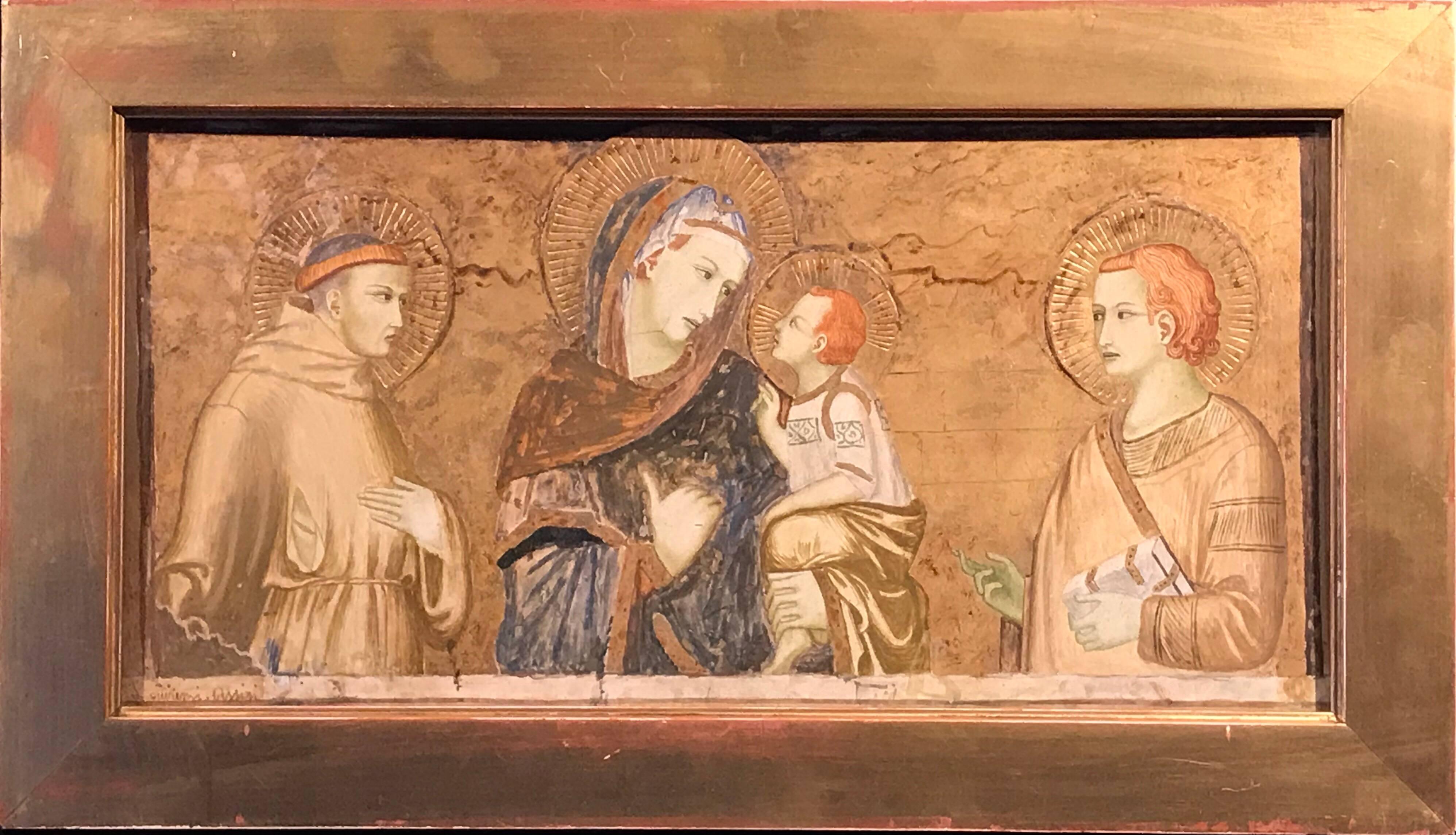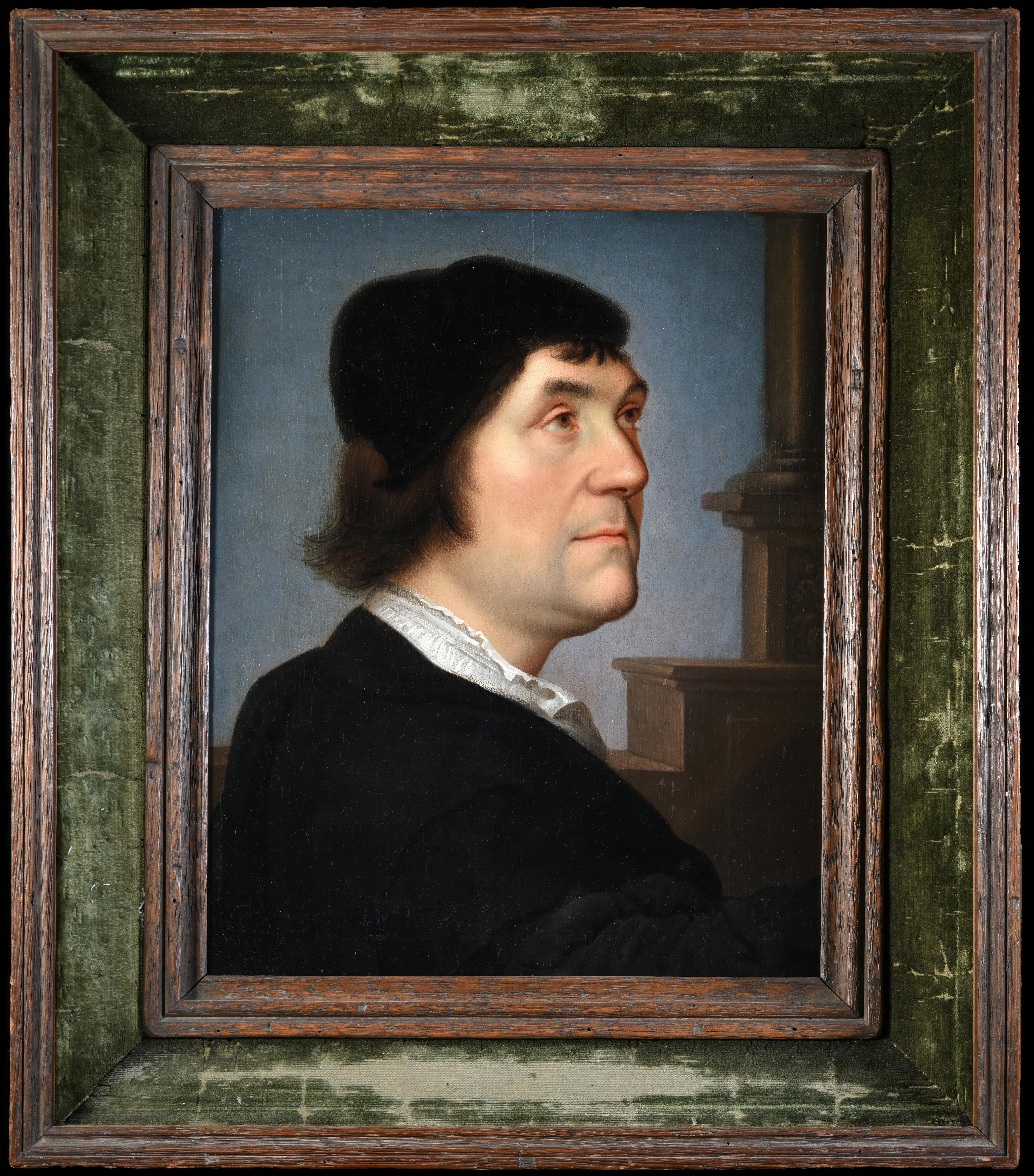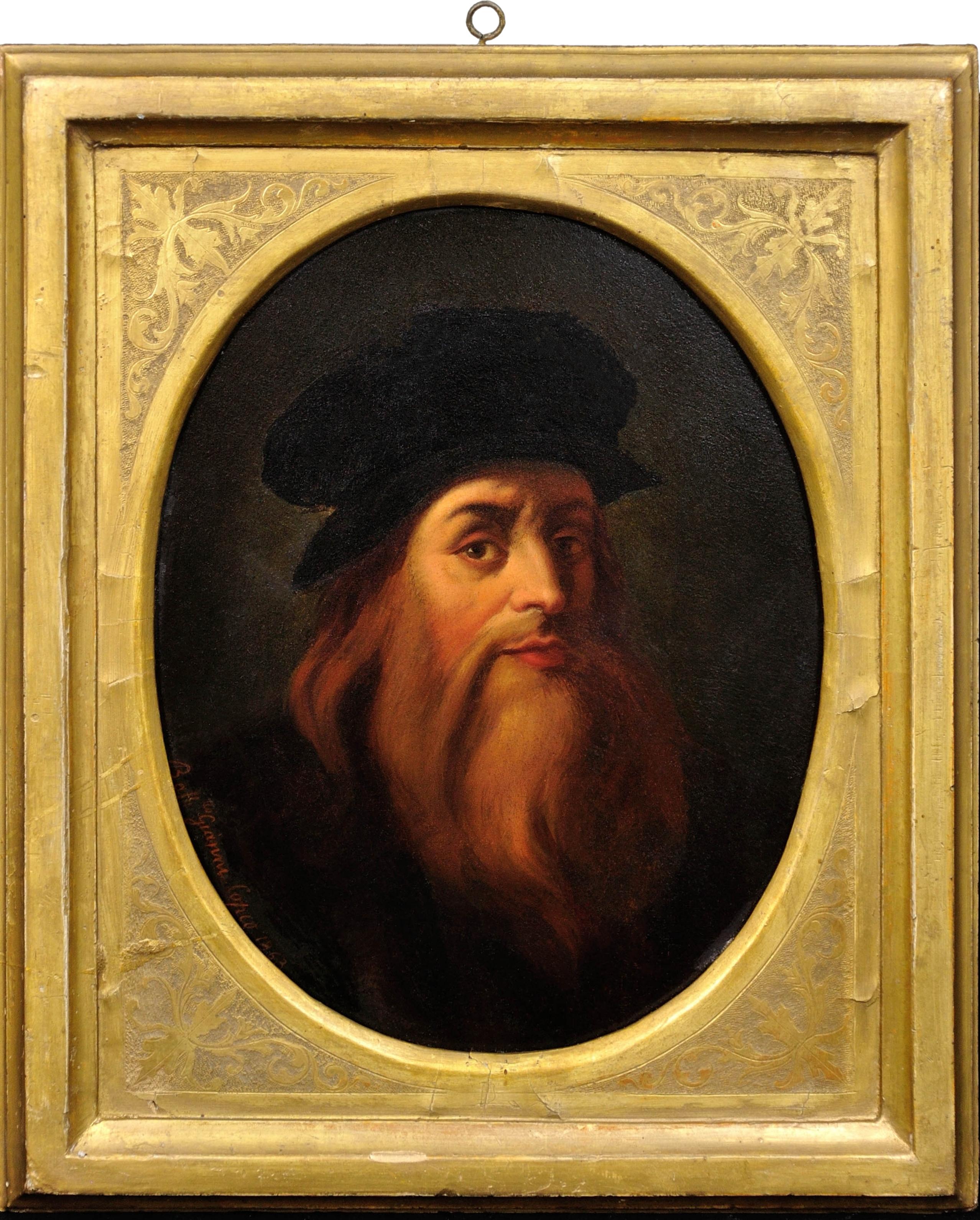Items Similar to Saint Cosmas And Saint Damian Attributed To Bonifacio Bembo
Want more images or videos?
Request additional images or videos from the seller
1 of 11
Saint Cosmas And Saint Damian Attributed To Bonifacio Bembocirca 1454 -1458
circa 1454 -1458
About the Item
Attributed to Bonifacio Bembo
c.1444-1477 Italy
Saint Cosmas and Saint Damian
Tempera on panel
These exceptionally rare early Renaissance panels of Saint Cosmas and Saint Damian are an extraordinary new discovery. Based on the research of art historians Marco Tanzi and Andrea de Marchi, it is believed that these represent the missing panels from the famed polyptych formerly displayed on the altar of the Chapel of San Nicola da Tolentino in the Church of Sant’Agostino in Cremona, Italy. To find two matching early Renaissance panels outside of a museum or church, particularly in such remarkable condition, is an extraordinary rarity.
The central and left-sided panels of the original five-part polyptych are currently in the collection of the Museo Civico Ala Ponzone in Cremona. These panels have luckily remained intact, and respectively portray the Madonna and Child Enthroned with Angels and Donor, Saint Nicholas of Tolentino (the chapel’s namesake) and Saint George.
While the present panels have since been reduced, that they belong to the Cremonese altarpiece is confirmed by a number of stylistic elements. All five panels contain the same rich decorative arabesque pattern on their stamped gold background, while the figures’ knurled haloes are identical in both their fineness of line and use of perspective. The proportions of the figures coincide perfectly; Saints Cosmas and Damian would have originally also been depicted as full-length figures, fitting into the vertical, Gothic style of the altarpiece.
According to the Christian religion, Saint Cosmas and Saint Damian were 3rd century physicians born in Arabia. Little is known about their lives except that they were reputedly twin brothers and that they were martyred in Syria during the persecution of Emperor Diocletian. It was believed that the saints were skilled in healing, and when their medicines failed, their faith and prayers could always perform miracles. Thus, the saints are often depicted with their medical equipment while wearing the traditional medieval doctor’s garb of crimson robes and distinctive round red hats.
The saints are similarly depicted in the present panels, though considering the manner in which they have been cut, their medical tools are not immediately evident. The saints were highly popular as patrons of wealthy families during the Gothic and Renaissance eras, particularly the Medici, and thus they occur frequently in art from the era. The twins, for instance, are found in the famed San Marco Altarpiece by Fra Angelico in the San Marco Museum (Florence), as well as in a set of Medici panels crafted by Filippo Lippi currently in the collection of the National Gallery (London).
Along with the remainder of the Cremonese altarpiece, these present panels have been attributed to the Northern Italian Renaissance painter Bonifacio Bembo. Active in Cremona throughout the 15th century, he would have been a natural choice for the construction of the altarpiece, which was to be part of a new chapel dedicated to San Nicola da Tolentina in the church of Sant'Agostino in Cremona. The Cavalcabò chapel, which is also in the Sant'Agostino, is similarly attributed to him. Several other of his works can be found in museums and churches throughout Italy and beyond, including the Pinacoteca di Brera (Milan), Denver Museum of Art, and the Musée des Arts Décoratifs (Paris), among others.
Circa 1454-1458
Panel: 14 5/8” high x 11 3/8” wide, (37.15 x 28.89 cm)
Frame: 22 3/4” high x 19 1/2” wide x 2 1/2" deep (57.79 x 49.53 x 6.35 cm)
- Attributed to:Bonifacio Bembo (1444 - 1477)
- Creation Year:circa 1454 -1458
- Dimensions:Height: 22.75 in (57.79 cm)Width: 19.5 in (49.53 cm)Depth: 2.5 in (6.35 cm)
- Medium:
- Movement & Style:
- Period:
- Condition:
- Gallery Location:New Orleans, LA
- Reference Number:
About the Seller
5.0
Vetted Seller
These experienced sellers undergo a comprehensive evaluation by our team of in-house experts.
Established in 1912
1stDibs seller since 2013
15 sales on 1stDibs
Typical response time: 3 hours
- ShippingRetrieving quote...Ships From: New Orleans, LA
- Return PolicyThis item cannot be returned.
More From This SellerView All
- Virgin and Child with the Infant Saint JohnBy Domenico PuligoLocated in New Orleans, LAA masterful example of Italian Mannerist painting, this exceptional panel was composed by the renowned Florentine painter Domenico Puligo. Alongside Jacopo Pontormo and Rosso Fiorentino, Puligo is remembered as one of the foremost figures of the Mannerist movement that rose to prominence during the 16th century in Florence. This panel of the Virgin Mary with the Christ child and Saint John the Baptist is a characteristic example of his celebrated devotional images, which grace museums such as the Metropolitan Museum of Art (New York), Museo del Prado (Madrid), Palazzo Borghese (Rome), and Palazzo Pitti (Florence), among many others. Puligo’s skill with color is fully demonstrated in the beautifully preserved work. Considering its age, the vibrancy and the sheer range of color is remarkable. The Virgin Mary’s crimson dress...Category
16th Century Mannerist Portrait Paintings
MaterialsOil, Panel
- Portrait Of A Gentleman By Frans HalsLocated in New Orleans, LAFrans Hals 1582-1666 Dutch Portrait of a Gentleman (possibly Theodore Blevet) Oil on panel “Frans Hals is a colourist among the colourists...Frans Hals must have had twenty-seven blacks...Category
17th Century Old Masters Portrait Paintings
MaterialsOil, Panel
- Josianna, Jeune Femme au Ruban by Jean Gabriel DomergueBy Jean-Gabriel DomergueLocated in New Orleans, LAJean-Gabriel Domergue 1889-1962 French Josianna, jeune femme au ruban (Josianna, Young Woman With Ribbon) Signed "Jean Gabriel Domergue" (lower left) Oil on panel A young French beauty known as Josianna is the subject of this work by Jean-Gabriel Domergue, and the oil on panel is a perfect example of the portraits for which the artist is renowned. His model embodies the concept of the la belle Parisienne: slender, swan-like women bearing an unmistakable grace and style. Domergue includes a delicate pink ribbon around her neck, suggesting a fashionable garment, set against a soft pastel-colored backdrop. The artist's oeuvre encompasses women from all facets of society, from aristocratic figures such as Liane de Pougy and Nadine, Baroness de Rothschild...Category
20th Century Post-Impressionist Figurative Paintings
MaterialsPanel, Oil
- Henry Bowles Howard, 12th Earl Of Suffolk And 5th Earl Of BerkshireLocated in New Orleans, LASir Joshua Reynolds 1723-1792 | British Sir Henry Bowles Howard, 12th Earl of Suffolk and 5th Earl of Berkshire Oil on canvas Sir Joshua Reynolds is unequivocally considered the most important English portraitist of the 18th century who was instrumental in adapting the Grand Manner style in the portrait genre. In fact, when the Royal Academy was founded in 1768, Reynolds was elected its first President, setting the precedent of quality for which all other portraitists would strive. Reynolds's portrait of Henry Bowles Howard, 12th Earl of Suffolk, showcases his genius in the genre and mastery over the medium. Reynolds’s portrait of the Earl expertly invokes classical values with strong lighting, rich colors and expert attention to detail to help underscore the prominence and revered echelon of the sitter. Howard was an esteemed British politician and Knight of the Garter. He served as Secretary of State for the Northern Department from 1771 to 1779, and he played a key role in utilizing mercenaries during the American Revolution and safeguarding Sweden's independence. The portrait employs Reynolds's signature style to render Howard rightfully as a gentleman of distinction. Captured seated in a stately library, the Earl appears learned and austere as he places one hand upon a stack of important documents and looks wistfully into the distance. Reynolds makes these compositional choices decisively, as the seated position gives Howard a weighty appearance of importance and the semi-profile turn captures his countenance at an attractive angle that highlights his strong, masculine features. The work draws on the classical conventions of Greek and Roman art and the Italian Renaissance masters, anchoring the nobleman in a history of refinement. Everything from his strong yet welcoming expression to his pale face enlivened by a rush of blood to the cheeks presents the picture of a strong, vital and powerful leader. As the first president of the Royal Academy in London, Reynolds’s commissions raised the status of an artist in Britain during the Romantic period and also established the portrait as an esteemed high art genre that garnered equal import to the history paintings that reigned supreme in decades prior. Today, Reynolds’s works grace the walls of the most important museums in the world, including the Louvre, the Metropolitan Museum of Art, and the National Gallery in London, among others. Circa 1770 Canvas: 50 1/2" high x 40 1/4" wide Framed: 61" high x 52 1/2" wide x 3 1/2" deep Provenance: Sir Henry Howard, 12th Earl of Suffolk and 5th Earl of Berkshire, 1739-1779 His mother, Lady Mary Howard, née Finch, Lady Andover, d. 1803 Acquired by descent to her daughter, Frances, and her husband Richard Bagot (later Howard) Acquired by descent to their daughter, Mary (1784-1877), and her husband Col. Fulke Greville Upton (later Howard), d. 1846 Acquired by descent to Lieutenant Colonel H.R.G. Howard Sale, Christie's, London, March 24, 1961, no. 29 Julius Weitzner, London and New York Sale, Paris, Musée Galliéra, December 7, 1965, no. 165 Newhouse Galleries, New York, NY Mr. and Mrs. F. Howard Walsh, Fort Worth, Texas, 1966 Walsh Family Art Trust Private collection, Oregon M.S. Rau, New Orleans Exhibited: British Institution, London, 1844, no. 130, loaned by the Hon. Fulke Greville Howard. South Kensington, "Second special exhibition of National Portraits," 1867, no. 478, lent by the Hon. Mrs. Greville. Agnew's, London, 1903, no. 17. Literature: Algernon Graves and W. V. Cronin, A History of the Works of Sir Joshua Reynolds, P.R.A., vol. 3 (London, 1899), p. 945. David Mannings...Category
18th Century Other Art Style Portrait Paintings
MaterialsCanvas, Oil
- Blackstone CigarsBy Norman RockwellLocated in New Orleans, LAA charming relic of a bygone era, this rare oil is the work of the inimitable American illustrator, Norman Rockwell. The iconic artist’s ability to render the details and nuances of ...Category
Early 20th Century Other Art Style Figurative Paintings
MaterialsOil, Canvas
- La lecture au jardin (Lesson in the Garden)By Georges d'EspagnatLocated in New Orleans, LAFrench Post-Impressionist painter Georges d’Espagnat captures a charming moment between a mother and her child in this vibrant oil on canvas. Rendered with a studied use of complementary colors and bold brushstrokes, the painting showcases the artist's unique Post-Impressionist style. Remembered as one of the most individualistic artists of the 20th century, his distinctive canvases bring together the loose brushwork of the Impressionists and the bold color palette favored by the Fauves. Together, they achieve a vibrant spontaneity that lends itself well to the carefree subjects of the present work. Masterfully composed, La lecture au jardin moves beyond the Impressionist instinct to capture a fleeting moment on canvas. Rather, d'Espagnat succeeds in creating a deep feeling of harmony in the work. Warm colors are perfectly balanced with cool tones, while vertical and horizontal lines are softened by the curves of the foliage and his subjects' figures. Through his simplification of forms and intentional use of color and line, he creates a scene that is carefully designed and thoroughly modern. A similar view of a mother and her child by d'Espagnat is currently in the collection of the Metropolitan Museum of Art (New York). The Post-Impressionist painter was an individualist since his youth, choosing to forgo traditional schooling in order to independently study the Old Masters in the Louvre. He soon became involved with the most prominent Impressionist and Post-Impressionist painters of the age, including Pierre-Auguste Renoir and Paul Signac, who themselves existed outside the traditional norms of French Academic training. In 1891, he exhibited at the Salon des Refusés, and again the following year at the Salon des Indépendants. By 1895, he held his first one-man show in Paris, and just three years later his success earned him a solo show at the prestigious Durand-Ruel Gallery. Between 1905 and 1910 he made several trips to visit Renoir on the Côte d’Azur. Their close friendship resulted in a group exhibition at Marcel Bernheim...Category
Late 19th Century Post-Impressionist Portrait Paintings
MaterialsCanvas, Oil
You May Also Like
- Portrait of an Italian NoblewomanLocated in London, GB15th century, Italian Circle of Antonio del Pollaiuolo (1429-1498) Portrait of an Italian Noblewoman Oil and tempura on poplar panel With partial inscription: ALZETAPIN Provenance:...Category
15th Century and Earlier Renaissance Portrait Paintings
MaterialsOil, Tempera, Wood Panel
- 18th Century Italian Masterpiece Madonna & Child after an earlier Giotto FrescoLocated in Cirencester, GloucestershireVery fine quality, rare and important early Italian Master painting depicting the Madonna and Child with Saints in attendance. The painting is ...Category
18th Century Renaissance Portrait Paintings
MaterialsGold Leaf
- A portrait of John Poyntz, after Hans Holbein, ca. 1644 - 1674By Hans HolbeinLocated in Brooklyn, NYA portrait of courtier and politician John Poyntz, after Hans Holbein, circa 1644 - 1674. This painting is based on a drawing by Hans Holbein, part of the drawings collection of the ...Category
Mid-17th Century Renaissance Portrait Paintings
MaterialsOil, Wood Panel
- after Leonardo da Vinci dated 1863. Self Portrait. Uffizi Gallery in Florence.By Leonardo da VinciLocated in Sutton Poyntz, DorsetSelf-Portrait of Leonardo da Vinci 1452 - 1519 after & of Leonardo da Vinci Italian, dated 1863 Signed Gianni Oil on Panel. Oval Image size 8.3 inches x 6.5 inches ( 21cm x 16.5cm ) ...Category
Mid-19th Century Renaissance Portrait Paintings
MaterialsOil, Panel
- 1700's Old Master Oil Wood Panel Five Female Saints Beautiful Quality workLocated in Cirencester, GloucestershireFigurative Group Roman Catholic Saints Italian School, late 17th century/ early 1700's sketch of a lamb showing verso to panel oil painting on panel, framed framed: 20 x 24 inches bo...Category
17th Century Renaissance Portrait Paintings
MaterialsWood Panel, Oil
- after Andrea del Sarto circa 1863. Portrait of Baccio Bandinelli. Uffizi GalleryBy Andrea Del SartoLocated in Sutton Poyntz, DorsetPortrait of Baccio Bandinelli 1493 - 1560 after Andrea del Sarto 1486 – 1530 Italian, created Circa 1863 Signed Gianni Oil on Panel. Oval Image size 8.3 inches x 6.5 inches ( 21cm x ...Category
Mid-19th Century Renaissance Portrait Paintings
MaterialsOil, Panel
Recently Viewed
View AllMore Ways To Browse
Early Renaissance
Saint Painting Antique
Saint George
Renaissance Panel
Antique Round Painting
Renaissance 15th
4 Panel 2 Sided Panels
Antique Doctors
Italian Renaissance Style Art
Arabesque Paintings
15th Saint
Portrait Doctor
Portrait Of A Doctor
Medieval Panel
Angel With Child
Medieval Saint
Italian Renaissance 15th
Italian Renaissance 15th Century




